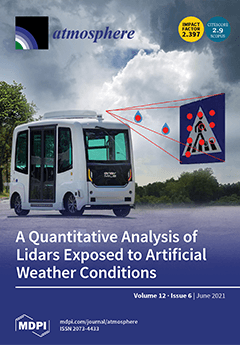Black carbon (BC) is of concern due to its contribution to poor air quality and its adverse effects human health. We carried out the first real-time monitoring of BC in Malaysia using an AE33 Aethalometer. Measurements were conducted between 1 January and 31 May 2020 in a university area in a suburban location of the Klang Valley. The measurement period coincided with the implementation of a movement control order (MCO) in response to COVID-19. The mean concentration of BC before the MCO was 2.34 µg/m
3 which decreased by 38% to 1.45 µg/m
3 during the MCO. The BC is dominated by fossil-fuel sources (mean proportion BC
ff = 79%). During the MCO, the BC
ff concentration decreased by more than the BC
bb concentration derived from biomass burning. BC and BC
ff show very strong diurnal cycles, which also show some weekday–weekend differences, with maxima during the night and just before noon, and minima in the afternoon. These patterns indicate strong influences on concentrations from both traffic emissions and boundary layer depth. BC was strongly correlated with NO
2 (
R = 0.71), another marker of traffic emission, but less strongly with PM
2.5 (
R = 0.52). The BC absorption Ångström exponent (AAE) ranged between 1.1 and 1.6. We observed pronounced diurnal cycles of lower AAE in daytime, corresponding to BC
ff contributions from traffic. Average AAE also showed a pronounced increase during the MCO. Our data provides a new reference for BC in suburban Malaysia for the public and policy-makers, and a baseline for future measurements.
Full article





